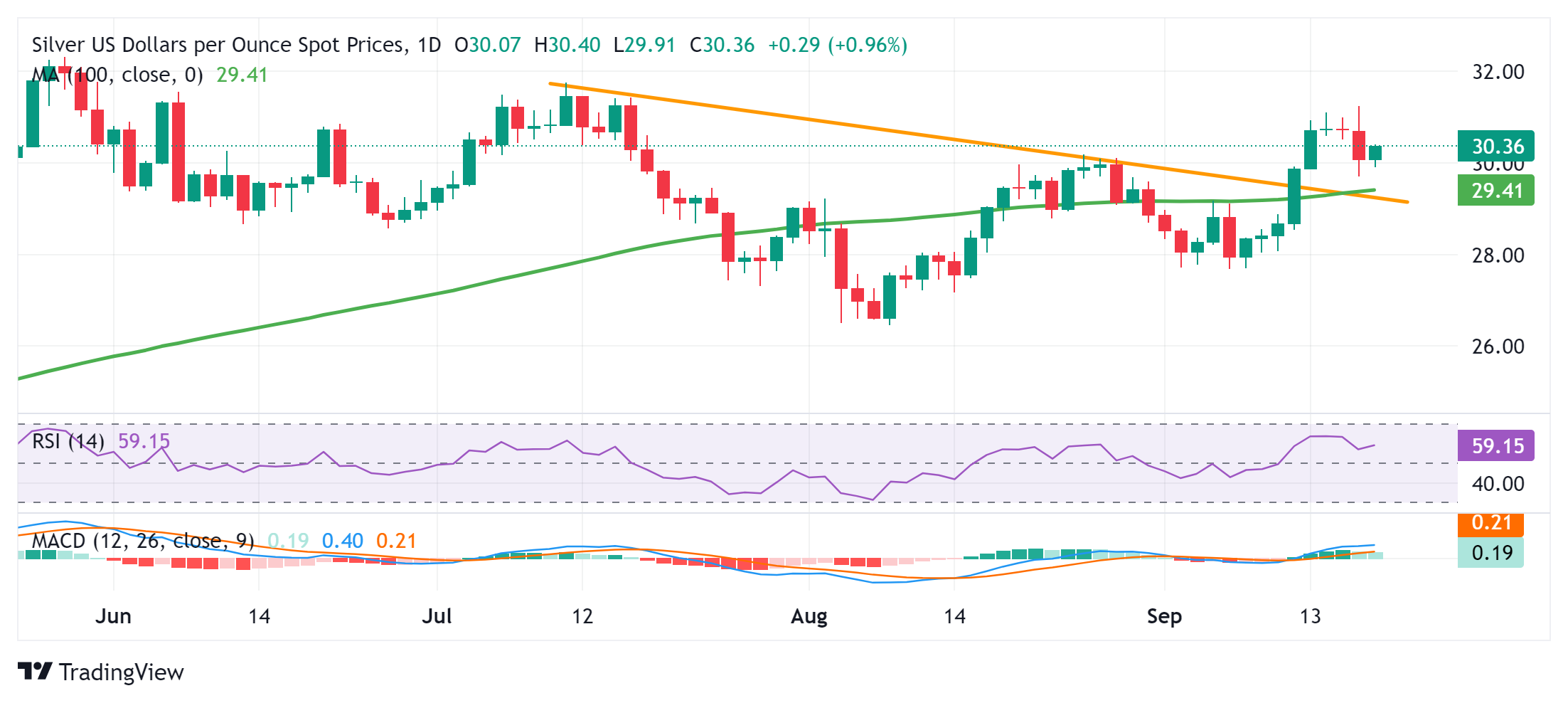Silver Price Analysis: XAG/USD climbs closer to mid-$30.00s, seems poised to appreciate further
- Silver attracts fresh buyers on Wednesday and reverses a part of the overnight retracement slide.
- The technical setup favors bullish traders and supports prospects for a further appreciating move.
- Weakness below the $30.00 mark could be seen as a buying opportunity and remain cushioned.
Silver (XAG/USD) regains positive traction during the Asian session on Thursday and moves further away from the weekly low, around the $29.70 area touched the previous day. The white metal currently trades around the $30.35-$30.40 region, up nearly 1% for the day, and seems poised to appreciate further.
The recent breakout through the $29.35 confluence – comprising a short-term descending trend-line and the 100-day Simple Moving Average (SMA) – and the emergence of dip-buying on Thursday validate the positive outlook. Moreover, oscillators on the daily chart are holding in positive territory and are still far from being in the overbought zone. This, in turn, suggests that that the path of least resistance for the XAG/USD is to the upside.
From current levels, any subsequent move up is likely to confront some resistance near the $30.65-30.70 horizontal zone, above which the XAG/USD could aim to reclaim the $31.00 mark. The momentum could extend further towards the overnight swing high, around the $31.30-$31.25 region. Some follow-through buying could lift the commodity to the $31.45 region en route to the July swing high, around the $31.75 zone, and the $32.00 mark.
On the flip side, weakness below the $30.00 psychological mark might still be seen as a buying opportunity and remain limited near the aforementioned confluence resistance breakpoint, now turned support near the $29.35 region. The latter should act as a pivotal point, which if broken decisively could drag the XAG/USD below the $29.00 round figure, towards the $28.45-$28.40 intermediate support en route to the $28.00 mark.
Silver daily chart
Silver FAQs
Silver is a precious metal highly traded among investors. It has been historically used as a store of value and a medium of exchange. Although less popular than Gold, traders may turn to Silver to diversify their investment portfolio, for its intrinsic value or as a potential hedge during high-inflation periods. Investors can buy physical Silver, in coins or in bars, or trade it through vehicles such as Exchange Traded Funds, which track its price on international markets.
Silver prices can move due to a wide range of factors. Geopolitical instability or fears of a deep recession can make Silver price escalate due to its safe-haven status, although to a lesser extent than Gold's. As a yieldless asset, Silver tends to rise with lower interest rates. Its moves also depend on how the US Dollar (USD) behaves as the asset is priced in dollars (XAG/USD). A strong Dollar tends to keep the price of Silver at bay, whereas a weaker Dollar is likely to propel prices up. Other factors such as investment demand, mining supply – Silver is much more abundant than Gold – and recycling rates can also affect prices.
Silver is widely used in industry, particularly in sectors such as electronics or solar energy, as it has one of the highest electric conductivity of all metals – more than Copper and Gold. A surge in demand can increase prices, while a decline tends to lower them. Dynamics in the US, Chinese and Indian economies can also contribute to price swings: for the US and particularly China, their big industrial sectors use Silver in various processes; in India, consumers’ demand for the precious metal for jewellery also plays a key role in setting prices.
Silver prices tend to follow Gold's moves. When Gold prices rise, Silver typically follows suit, as their status as safe-haven assets is similar. The Gold/Silver ratio, which shows the number of ounces of Silver needed to equal the value of one ounce of Gold, may help to determine the relative valuation between both metals. Some investors may consider a high ratio as an indicator that Silver is undervalued, or Gold is overvalued. On the contrary, a low ratio might suggest that Gold is undervalued relative to Silver.

